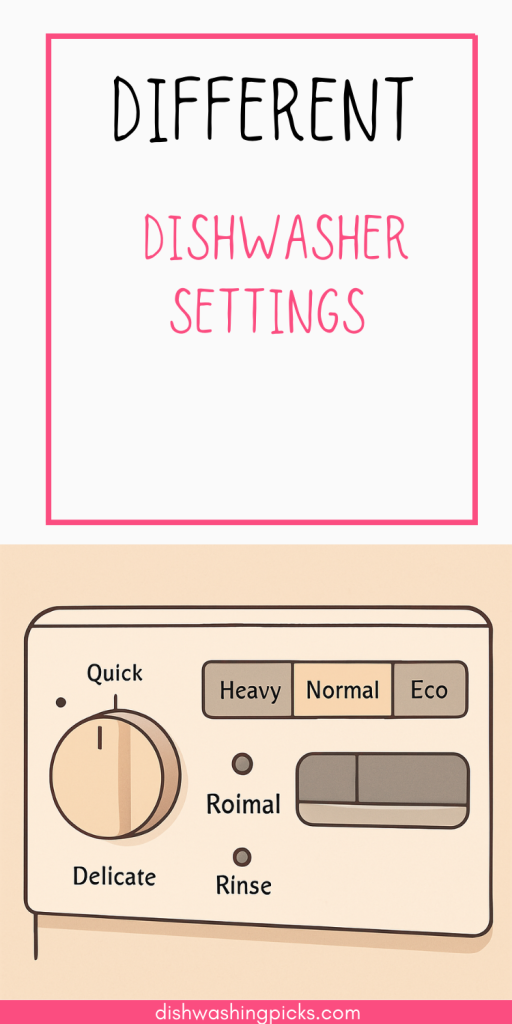
First, let’s talk dishwashers. Not exactly the most thrilling subject, but we all use them, so let’s make it interesting, shall we? If you’ve ever stared at your dishwasher’s control panel, wondering what in the world all those buttons mean, you’re not alone. Heavy wash, normal wash, eco-mode—what’s the difference? And which one should you choose for your load of dishes? Don’t worry, I’ve got you covered. Let’s break it down!
The “Normal” Setting: The Go-To Option
Let’s kick things off with the “Normal” setting. This is probably the one you use most often, right? It’s the all-around, no-fuss option that gets the job done for everyday dishes. Plates, bowls, cups—throw ‘em in and press the button. Simple.
But here’s the thing: if your dishes are just a little bit dirty, like a couple crumbs or some sauce splashes, “Normal” is perfect. But… what if you’ve got some really baked-on stuff, like last night’s lasagna leftovers? Or that pasta pot that looks like it had a small grease fire? In that case, it’s time to step it up.
Heavy Duty: When Your Dishes Need a Power Boost
This is where the “Heavy” or “Pots & Pans” setting comes into play. You know those dishes that you’re kind of embarrassed to put in the dishwasher? Yeah, the ones that look like they could double as a fire pit? This setting is for those. It’s like your dishwasher’s workout routine—lots of water pressure and a longer wash to tackle the toughest, grimiest messes.
So, if you’ve got a seriously dirty pot, greasy baking sheet, or anything that needs some extra TLC, hit the “Heavy” setting. Your dishwasher will put in the work and leave you with a nice clean dish, minus the elbow grease.
Eco Mode: Saving the Planet, One Dish at a Time
Now, let’s talk about “Eco” mode. Sounds like the perfect setting for all you environmentally conscious folks, right? And you’re absolutely right—it’s great for saving water and energy. If you’re thinking of doing your part to reduce your carbon footprint (or just want a cheaper water bill), this is the way to go.
But, here’s the thing: Eco mode uses less water, which can make it take longer to clean your dishes. So, if you’re in a rush and your dishes are just a little dirty, you might want to save the eco setting for another time. On the flip side, if you’re not in a hurry, and want to be more energy-efficient, eco-mode is your best friend.
Quick Wash: When You’re in a Hurry
Sometimes, you just don’t have time to wait an hour or more for your dishes to finish their cycle. That’s where the “Quick Wash” setting shines. It’s perfect when you need clean dishes fast—maybe after a casual dinner party or a quick lunch with friends. It won’t scrub every speck of grime off, but it will get your dishes clean enough for the next use.
Just know that quick washes typically don’t handle heavy-duty messes very well. So if you’ve got greasy pans or baked-on cheese, you might want to give this one a skip.
Delicate or China: Handle with Care
Okay, now we’re diving into “Delicate” or “China” settings. You know those fancy plates you keep for special occasions (like the ones you only bring out for Thanksgiving and Christmas)? These settings are made just for them. They use gentler water pressure and a slower wash to keep your fine china, crystal glasses, and delicate dishware safe from damage.
If you’ve got expensive plates or fragile items, don’t even think about putting them on the “Heavy” setting. You’ll end up with broken dishes—and nobody wants that. So, for your delicate treasures, choose this setting and let your dishwasher treat them like royalty.
The Rinse Cycle: Prepping for the Big Wash
Now, let’s talk about the “Rinse” setting. You might be wondering, “Why not just throw my dirty dishes in and let the full cycle do its thing?” Well, the “Rinse” cycle is like the appetizer to your main dish. It’s a quick rinse to help keep your plates from smelling until you’re ready to do a full load. It won’t clean your dishes entirely, but it’ll prevent that gross, leftover food smell from sticking around.
If you’ve got a few dishes sitting around before you do a full load, just hit the rinse cycle to hold them off until you’re ready. It’s like a little dishwashing preview.
Conclusion: Choose the Right Setting for the Job
So, there you have it! All those buttons on your dishwasher aren’t just there for decoration. Each setting has its own job to do, whether it’s tackling heavy messes, saving water, or keeping your fragile dishes safe. The key is knowing what each one does and picking the right setting for the load you’re dealing with.
Next time you’re staring at your dishwasher’s control panel, take a second to think about what you’re washing, and choose accordingly. It’ll save you time, water, and even your favorite dishes!
Ready to get the most out of your dishwasher? Try experimenting with different settings, and see what works best for your needs. And hey, if you’re feeling extra eco-friendly, why not give that Eco mode a go? Your dishes—and the planet—will thank you.
That’s a wrap! Hopefully, this clears up some of the confusion about your dishwasher’s settings and makes dishwashing a little less of a mystery. Now, go forth and wash those dishes like a pro!

